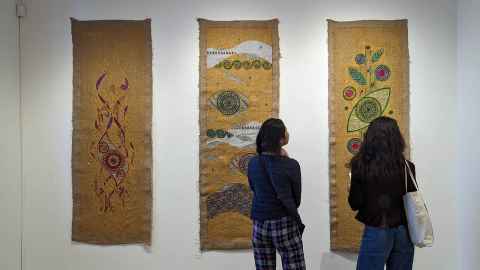From the Collection: forces of nature
1 July 2025
Deities of Indigenous Filipino mythology come to life in new additions to the University’s art collection.

The Science Centre on Symonds Street offers a curator a unique opportunity to bring artworks into conversation with the learning and research that happens there.
As the home to the School of Environment, for example, many of the building’s artworks feature ecological subjects and natural phenomena – like Fiona Pardington’s Inseperable Huia, which greets students in the atrium. Then there’s John Reynolds’ Speaking Truth to Power series, which playfully explores academia and intellectualism in Aotearoa, engaging visitors to the School of Psychology on the fourth floor.
Introducing a contemporary voice to this ongoing dialogue is a pair of new acquisitions to the University’s art collection: Lalahon (2023) and Kalikhasan (2023), which are two of three hessian artworks (alongside Habagat at Amihan, 2023) by Filipino-New Zealand artist Louie Bretaña (b. 1967).
With parental roots in Manila and the Visayan province of Iloilo in the Philippines, Bretaña holds a Bachelor of Fine Arts from the University of the Philippines, and had an early career in advertising in the country.
He immigrated to Aotearoa in 2011, where he pursued his artistic practice at Elam School of Fine Arts, gaining a Bachelor of Arts (First Class Honours, 2017) and a Master of Fine Arts (2018).
In the years since, Bretaña has developed notable solo exhibitions, including Tumingala sa tinitingala na mga tala at Te Uru Gallery (Titirangi, 2021), which included a memorable series of suspended sculptures based on parol (ornamental Christmas lanterns from the Philippines).
Bretaña is known for sparking wonder and delight with his spiritually infused works, which incorporate materials and techniques bridging painting, sculpture, adornment, and performance-based practice. His works are laden with symbolism, often referencing Indigenous Filipino diwatas (deities) and exploring the interconnectedness of anito (ancestral spirits) and the natural world.
Bretaña is known for sparking wonder and delight with his spiritually
infused works
Lalahon and Kalikhasan are two such references, each honouring a mythological diwata from the natural environment and invoking them as guardians over the unruly forces of nature that increasingly impact our modern world.
Employing unstretched hessian as his canvas, Bretaña juxtaposes the humble textured surface with vibrant swathes of acrylic, shimmering glass crystals and golden glitter, to create an alluring homage to the diwata depicted.
In Philippine mythology, Lalahon is revered as the goddess presiding over volcanoes and harvests. She commands fire, eruptions and seismic activity, with the ability to wield immense power.
Despite her potential for devastation, she equally assumes a protective role as the goddess of harvests and agriculture. She is venerated for bestowing prosperity on the farming communities of the Visayas, where she is linked to concepts of fertility and abundance.
Her neighbour, Kalikhasan, is more broadly understood as the diwata of nature, earth and creation itself. Kalikhasan’s name is derived from two words: kalikasan (nature) and likha (to create).
Bretaña has inscribed the represented diwata’s name in Baybayin, an ancient Philippine script, on the edge of each work, equally enshrining and commemorating them using a centuries-old Philippine language.
In their glistening forms, Bretaña’s meditative diwatas ponder the entanglements of tradition and modernity, spirituality and nature, and art and science.
The artworks are on the ground floor of the Science Centre, 23 Symonds Street.
Madeleine Gifford, Art Collection Adviser
This article first appeared in the July 2025 issue of UniNews.